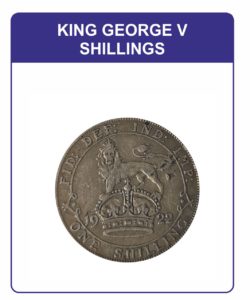One Shilling
 |  |  |
The Shilling was worth one twentieth of a pound or twelve old pennies. This was in the days when there were 20 shillings to one pound. The current equivalent value in decimal coinage is five new pence.
The shilling was first minted in the reign of Henry VII and was called the testoon. It became the shilling from the old word “scilling” during the sixteenth century. The shilling was also referred to as the “bob”, i.e. one bob for a shilling and ten bob for a ten shilling note.
The shilling was produced in both an English and a Scottish design and these designs are both available from our shop. The designs of these coins changed when issued for Queen Elizabeth II but the separate Scottish and English shillings were still available
Although the shilling was not produced until the sixteenth century, the value of the coin has been used for accounting purposes since the Anglo Saxon era and understood to be the value of a cow in Kent or a sheep elsewhere.
During the nineteenth century the mint was instructed to coin one troy pound (weighing 5760 grains or 373 g) of standard (0.925 fine) silver into 66 shillings. This set the weight of the shilling, and its subsequent decimal replacement 5 new pence coin, at 5.6 grams from 1816 until 1990, when a new smaller 5p coin was introduced.
A shilling equates to two Sixpences, four Threepence, twelve Pennies or twenty four Halfpennies.
The shilling measures 23.5mms in diameter and weighs in at 5.65 grams.
From 1920 to 1946 shillings were produced from 50% silver content and prior to 1920 they were, in fact, produced in Sterling Silver (92.5%).
We have a vast range of shillings available to our customers whether your requirement is for a single coin or for a “bulk” order. For “bulk” orders please contact us to discuss your requirements and get further information.
